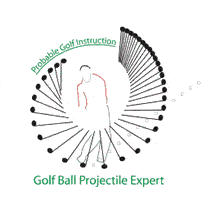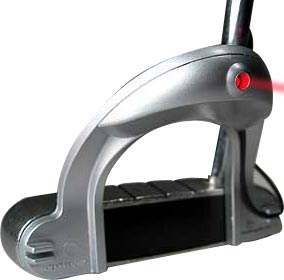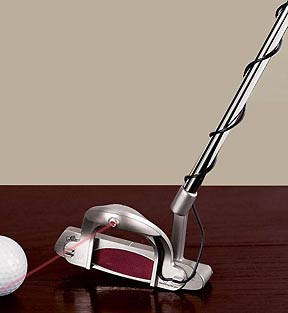
|
|
|
New pages:How to Sink More Short Putts -- June 20/13 Golf Club Range Calculator -- Temperature, Altitude, Wind -- July 1/13 Golf Driver Launch Angle = Distance -- August 15/13 Best Golf Ball for Your Game -- September 5/13 The Best Golf Ball for Your Golf GameGolfers are always striving for more distance. Of course, the best way to is try to improve one's swing and increase one's swing speed. That, however, can be quite challenging, especially if you and youth have grown apart. Golf equipment has been responsible for greater distance in recent years. The main technological improvements have been in the large headed metal woods with spring-like club faces (tampoline effect) and in ball technology. If you want to learn more about improving your distance by getting a Driver with the correct loft, go to this page: Golf Driver Launch Angle for Maximum Distance This page is about finding the best golf ball for your game. One that provides you with the most distance off the tee, yet adequate spin and feel so that you can stop the ball close to the pin and putt well. A few years ago, Golf Magazine had a study conducted using a golf robot so that swing speed and impact position were kept constant. The robot tested over 50 balls for total distance (carry plus roll) off a driver. An industry-leading club was used with the following conditions: 90 mph swing speed (average golfer), 137 mph ball speed, 14-degree launch angle, 2,900 rpm. The Trackman Doppler Radar was used for all measurements. Limitations and Cautions Please note that such tests have a number of different variables such as fluctuations in: *air temperature (carry distance changes by about about 0.5 yd per degree Celsius)
Between the Titleist and Bridgestone brands, there was an 8.5 yard spread (3% variation). Taking into account the "Limitations and Cautions" this is not very significant, especially considering the variation in the amount of roll which is dependent on where the ball lands on the grass (firmness of ground and thickness of grass). I did an analysis a few years ago on the statistical significance of golf ball distances. If you're interested in a more detailed analysis, you can learn more HERE. The Titleist & Bridgestone balls are 3-piece construction with urethane covers (softer, more feel and spin). The Pinnacle & Precept balls are typically 2-piece construction with harder, more resilient covers (harder, less feel and less spin). In my opinion, the small difference in distance (might not even be statistically significant) is not worth sacrificing the loss of feel and spin. I think most golfers benefit from a softer, higher spin ball from 100 yards and in (wedge game, chipping, putting).
You've probably heard the expression, "There are lies, damn lies, and then there are statistics!" Statistics can be very misleading if not represented well. Take for instance the bar graphs above. Note that the distance scale starts at about 230 yards instead of 0 yards. To actually represent any differences in distances correctly, one should plot them on a scale starting at 0 yards. I replotted the low and high distances from each category of balls with a scale of 230 to 300 yards and then with a scale of 0 to 300 yards.
Note that when displayed "fairly," there does not appear to be a significant difference in the ball distances except for #6, which is the Nike One Platinum (designed for premium, long hitters that don't worry about a little loss in distance). All of the above data is for swing speeds of 90 mph (average golfer). My more thorough statistical analysis also looks at data from 100 mph swing speeds. I have learned that even lower swing speeds are much more sensitive to launch angles changes and the amount of backspin on the ball. Another 200 rpm in backspin will yield a greater increase in distance for a 90 mph swinger than a 100 mph swinger, given everying else is the same. Likewise, an 80 mph swinger will yield a greater increase in distance than a 90 mph swinger.
A slow swinger will also have much lower trajectories. A slight increase in backspin will produce a higher trajectory and thus more distance. Thus, a slow swing speed swinger is more distance sensitive to the type of ball he/she plays. If one were to repeat the above robot tests with an 80 mph swing speed, I would expect to find a larger range of distances between the different golf balls.
Above are the trajectories of an 80 mph swinger with three different backspin values. Note that the higher the backspin, the higher the launch angle and carry distance, as well as the lower the impact angle (thus more bounce and roll on dry fairways). There is a 10 yard (6 % compared to 160 yd) carry distance between the 2000 rpm trajectory and the 2800 rpm trajectory. Thus, the Titleist NXT might produce more distance off the tee not because it comes of the clubface with more speed, but because it comes off with a steeper launch angle and/or backspin.
The graph above is for 120 mph swinger trajectories with the same backspin values. Note that the higher backspin value leads to greater carry but the impact angles do not change by more than 1 degree. The difference in carry between 2000 rpm and 2800 rpm is only 7 yards (2.5% compared to 285 yd). Here are the numbers in a table with total distances assuming semi-firm fairways: 120 mph Swing Speed
80 mph Swing Speed
But again, remember, that driving is only one part of the game. The higher your handicap, the less its importance. For example, if you average 100 for 18 holes, you'd only use the driver a maximum of 14 times (14% of the time). A high handicap golfers plays a much larger percentage of his/her shots from within 100 yards, where sufficient spin and feel are important. Here's a graph from a study done by Golf Digest on wedge backspin. Notice that the NXT has midrange backspin, so it might be a really good fit for a high handicapper game. I still feel, however, that it's better to play with a higher spin ball because you'll develop a better feel around the green than the amount of distance you'd gain off the tee (for 14% of your shots).
If you value scoring as low as possible day in and day out, it's important that you play a ball with great spin and feel. You need significant spin to stop the ball on the green, close to the flag, especially with the wedge (your scoring club). You also want significant feel around and on the green. A softer covered ball that will give you the added feel necessary, especially on fast greens. I personally play the Titleist Pro V1 and my club head speed is about 100 mph. I love the soft feel and significant backspin for my short game. I don't find that I lose any significant distance compared to the harder 2-piece balls. I must say I really like Titleist's Golf Ball Fitting Procedure. I suggest you try it out. Golf Digest did an interesting study which it announced in its May/05 issue. They had Golf Laboratories test several balls with their launch monitor and computer-controlled robot using a 10-degree Callaway driver and Titleist NXT golf balls. The balls varied in condition, though. In the table below are the results for the different conditioned balls. All distances are in yards. Dispersion is the yardage off-line, left or right of the target.
As you can see, there's not a significant difference in total distances. Note the much greater dispersion for the "Mud" ball, however. Thus, always wash your golf balls at the end of each hole.
I've written a little spreadsheet program to keep track of your putting statistics. Make a purchase of anything I sell from my site and I'll send it to you as a BONUS. Just send me an email after your purchase to let me know you'd like it. OR, you can purchase it for only $9.99.
Proper alignment can be learned. It can be mastered. You just need to know how you're aligning. You need a measuring tool to let you know. You need a Laser Putting Alignment System. Take a look at the Laser Putting Device that I use and consider getting one for yourself Order yours TODAY! Only $49.95
Golf Balls & Temperature -- Learn how temperature affects the distance a golf ball carries.
©Probable Golf Instruction, Ken Tannar 2001-2013. All Rights Reserved. Langley, B.C. V2Y 2G4 CanadaPhone: 604-309-7030 FAX: to fax, email an attachment probablegolf@yahoo.ca or golfexpert@probablegolfinstruction.com |
| GOLF ASSISTANTS |
|
Golf Trip Pairing CalculatorPlanning a golf trip with some friends/family? Trying to sort out the foursomes so people don't play too often with others? Order your ready made Spreadsheet. Type in the names, print out the groupings. Minimize repeat pairings.
Wind Caddy will advise you on aim, distance and club so that you can play the wind successfully. It takes the guess work out of club selection. New option to enter custom distances for each club. The algorithm will make a club suggestion accordingly. Use the right club in every condition!
|
|
|
| GOLF NEWS |
Golf Putting Green Reading Glasses |
| GOLF NEWSLETTER |
Statistics
·Putting
·Long Balls
·Games
·Handicap
·Scoring
·Shot Patterns
·Tournaments
·Tours
Pro Shop
·Ball Marker Engraved
·Books
·CDs & DVDs
·Green Reader
·Impact Labels
·Laser Rangefinder
·Longer Drives
·Products
·Teaching Aids
|
Subscribe to the Probable Golf Newsletter
and
|
| GOLF POLL |
The 19th Hole
·Advertising
·Ask the Golf Expert
·Consultation/Litigation
·FAQs
·Golf Blog
·Golf Draws
·Links
·Science of Golf
·Tell a Friend
·Testimonials
·

Golf Ball Finder Glasses
Find all your errant golf balls and many more!
| GOLF TIPS |
How to play:
|





















